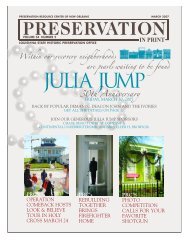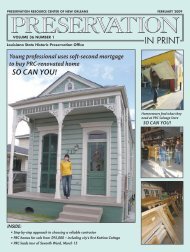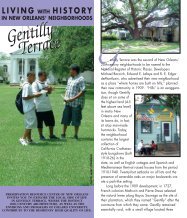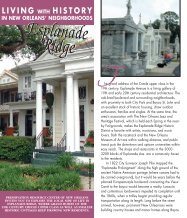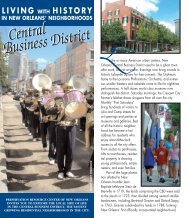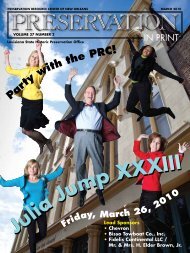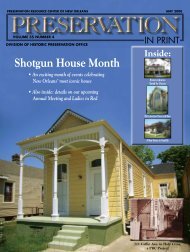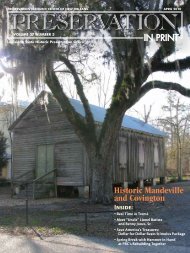Preservation Resource Center
Preservation Resource Center
Preservation Resource Center
You also want an ePaper? Increase the reach of your titles
YUMPU automatically turns print PDFs into web optimized ePapers that Google loves.
PRESERVATION IN PRINT APRIL 2007 17<br />
GUEST<br />
VIEWPOINT<br />
The Unreported Influx<br />
of Bright and<br />
Energetic Residents to<br />
New Orleans<br />
Stephen Hales, M.D.<br />
This op ed originally appeared in the Times-Picayune and is reprinted here with<br />
writer’s permission.<br />
R<br />
ecently the New York Times carried<br />
a story on its front page<br />
under this headline: “New<br />
Orleans’s New Setback: Fed-up Residents<br />
Giving Up.” The article profiled several<br />
families who are leaving New Orleans<br />
because the pace of recovery is “too little,<br />
too late,” an understandable assessment.<br />
The article itself, while more<br />
nuanced, generally supported that statement.<br />
“We don’t have to go through<br />
this” would fairly represent the sentiments<br />
of those who have chosen to<br />
leave.<br />
But a different headline, equally as<br />
true, might have been this: “A Unique<br />
City Continues to Hold and Attract<br />
Committed Citizens.” Support for that<br />
alternative headline was found, in fact,<br />
in the text of Shaila Dewan’s article, as<br />
demographers and others described not<br />
only a hard-to-quantify “brain drain,” but<br />
also a determined and passionate core of<br />
New Orleanians choosing to stay, and a<br />
steady, if under-reported, flow of new residents<br />
who see both challenge and<br />
opportunity in this badly damaged city.<br />
“The pattern in is certainly stronger than<br />
the pattern out,” said one demographer.<br />
So why does the story run under the<br />
first headline, sure to be seen far and<br />
wide as one more piece of bad news documenting<br />
our city’s slide into oblivion<br />
Headlines count, leaving impressions<br />
that are hard to change, and I can only<br />
wish they had chosen the second one.<br />
I have been a pediatrician in New<br />
Orleans for more than thirty years, long<br />
enough to see a generation of babies<br />
grow up and, now, to help care for their<br />
babies. While I will not offer my experience<br />
as a substitute for the academic<br />
analyses of statisticians and demographers,<br />
I will cite my own less formal, but<br />
very personal survey of the flow of families<br />
in and out of our city.<br />
In the months after the storm, when<br />
we were able to come back to the city,<br />
open our office, and begin to care for our<br />
stunned and stressed families as they<br />
returned to pick up the pieces of their<br />
lives, demographic dynamics became<br />
very personal. Each day we collected<br />
from the fax machine and the occasional<br />
mail delivery requests for the medical<br />
records of children we had cared for<br />
through their young lives. There were so<br />
many such requests – from Dallas and<br />
New York, Denver and Houston, Atlanta<br />
and San Francisco.<br />
A unique city<br />
continues to<br />
hold and attract<br />
committed<br />
citizens<br />
But there were many families who<br />
chose to stay, for the whole range of reasons<br />
the New York Times article cited –<br />
for family, for jobs, for the keenly felt<br />
need to rebuild their homes, and their<br />
city. And, to our surprise, we began to<br />
see a flow of new patients and families<br />
into our practice from all over the country.<br />
Young families – educators, attorneys,<br />
physicians, and business people –<br />
arrived to replace those who left after the<br />
storm, or to begin new ventures made<br />
possible by the profound changes which<br />
followed Katrina. And we began to see<br />
more and more babies born in our<br />
remaining hospitals, perhaps the most<br />
significant vote of confidence in the<br />
future. We have found, over the past<br />
year, that the net of those flows in and<br />
out has turned decidedly positive.<br />
www.prcno.org<br />
Does that mean all is well in New<br />
Orleans Clearly, it does not. New<br />
Orleans faced significant problems before<br />
the flood, and those have become even<br />
more evident and wrenching as we<br />
rebuild our city. This is not an easy<br />
place to live right now. We recognize it<br />
when we experience the daily reality of<br />
broken traffic lights, pot-holed streets, a<br />
dysfunctional criminal justice system,<br />
and challenged health care resources.<br />
We see it when we travel to other cities,<br />
where things are “normal,” and the conditions<br />
we face each day would not be<br />
tolerated. Enormous challenges – unique<br />
in the history of our nation – remain in<br />
restoring housing lost when 80 percent of<br />
our city was flooded. We live with the<br />
pervasive sense that we have been failed<br />
by our elected leaders.<br />
But I strongly believe that the pessimistic<br />
“giving up” New York Times<br />
headline does not convey the reality I<br />
see day in and day out in my office, or in<br />
my city. Citizen-led initiatives have<br />
brought real change and reform to<br />
entrenched political structures, structures<br />
which have served New Orleans poorly<br />
for generations. The failed public school<br />
system is in the midst of a transformation<br />
led both by committed New Orleanians<br />
and an influx of bright and energetic<br />
educational reformers, school leaders,<br />
and teachers who are here because there<br />
is an unparalleled opportunity to “make a<br />
difference.”<br />
I was not born here, but found in this<br />
city many years ago a rich and engaging<br />
culture, place, and people. We have lost<br />
many wonderful families, and will<br />
undoubtedly lose more. This will be a<br />
To our surprise,<br />
we began to see<br />
a flow of new<br />
patients and<br />
families into our<br />
practice from all<br />
over the country.<br />
long process, and will require the devotion,<br />
vision, and hard work of those who<br />
choose to remain, and those who choose<br />
to come here to help this city rebuild.<br />
There are many who fit those descriptions<br />
– more, I believe than those who<br />
make the choice to leave. I hope that in<br />
a future story, and under a more optimistic<br />
headline, the New York Times will<br />
return to tell that story.






